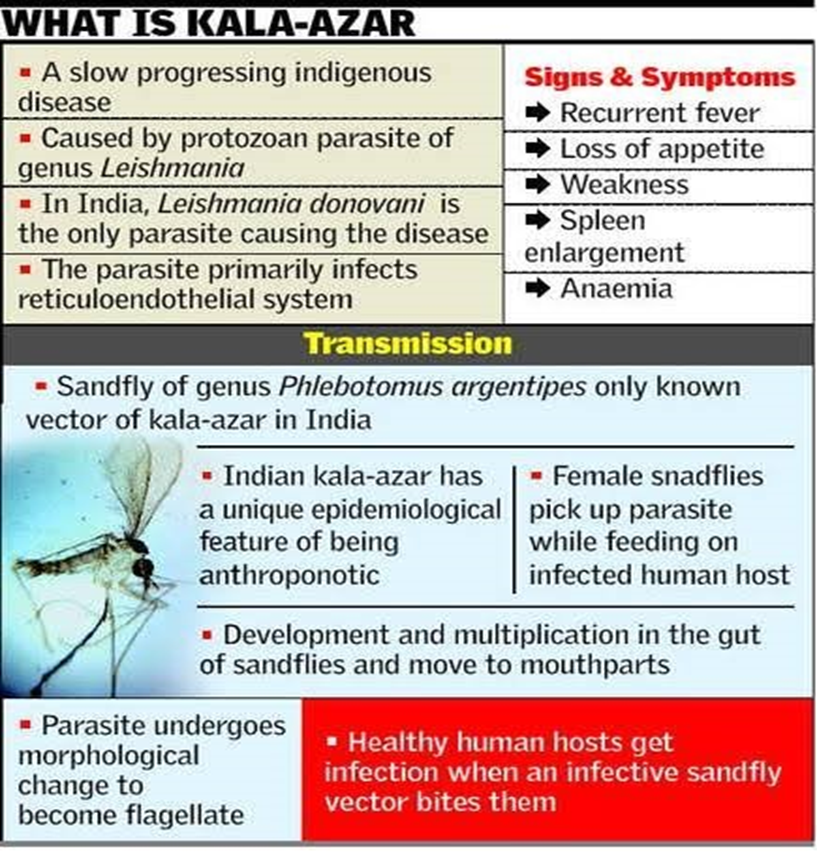- Courses
- GS Full Course 1 Year
- GS Full Course 2 Year
- GS Full Course 3 Year
- GS Full Course Till Selection
- Online Program
- GS Recorded Course
- NCERT (Recorded 500+ Hours)
- Polity Recorded Course
- Geography Recorded Course
- Economy Recorded Course
- AMAC Recorded Course
- Modern India, Post Independence & World History
- Environment Recoded Course
- Governance Recoded Course
- Science & Tech. Recoded Course
- International Relations and Internal Security Recorded Course
- Disaster Management Module Course
- Ethics Recoded Course
- Essay Recoded Course
- Current Affairs Recoded Course
- CSAT
- 5 LAYERED ARJUNA Mentorship
- Public Administration Optional
- ABOUT US
- OUR TOPPERS
- TEST SERIES
- FREE STUDY MATERIAL
- VIDEOS
- CONTACT US
INDIA ACHIEVES TARGET TO ELIMINATE ‘KALA-AZAR’
INDIA ACHIEVES TARGET TO ELIMINATE ‘KALA-AZAR’
India has achieved its target to eliminate visceral leishmaniasis, commonly known as kala-azar, according to data from the National Centre for Vector Borne Diseases Control (NCVBDC). India had initially aimed to eliminate kala-azar by 2010, but the target was extended until 2023 due to persistent challenges.
|
The National Vector Borne Disease Control Programme (NVBDCP) started in 2003-04 to prevent and control diseases like Japanese Encephalitis (JE), Dengue, Kala-azar, Lymphatic Filariasis, Malaria, and Chikungunya. |
Decline in Kala Azar Cases in India
- In 2023, India fulfilled the World Health Organization's (WHO) elimination criteria for kala-azar by recording only 520 cases nationwide.
- WHO's criteria requires that no area within a country should report more than one case per 10,000 people.
- In 2020, India accounted for 18% of the world's kala-azar cases, as per WHO data.
What is Kala-Azar?

|
Aspect |
Details |
|
About |
|
|
Transmission |
|
|
Symptoms |
|
|
Impact |
|
|
Fatality rate |
|
|
Treatment |
|
Note- Post kala-azar cutaneous leishmaniasis (PKDL) – This occurs when Leishmania donovani invades and multiplies skin cells, causing skin lesions. PKDL usually appears after kala-azar treatment.
Strategies Adopted to Eliminate Kala Azar in India
- Intensive indoor residual spraying: To target and reduce sandfly breeding areas, intensive indoor residual spraying is performed.
- Plastering the wall with Gerard clay: To prevent sand flies from making nests, the walls are coated with a specific clay known as Gerard clay.
- Treatment Compliance Monitoring: The Accredited Social Health Activists (ASHA) network is engaged in monitoring the completion of treatment of PKDL patients while ensuring compliance.
Three mains form of the Kala-azar
- Visceral leishmaniasis (VL), the most severe form of leishmaniasis, affects multiple organs.
- Cutaneous leishmaniasis (CL), the most common form, causes skin ulcers, primarily on exposed body parts, which can lead to permanent scars, disability, or stigma.
- Mucocutaneous leishmaniasis, a severe form, destroys mucous membranes in the nose, mouth, and throat, leading to extensive damage.
The Indian government has taken several steps to eliminate kala-azar, also known as visceral leishmaniasis, including:
Programmatic activities:
The National Vector Borne Disease Control Programme (NVBDCP), which is part of the National Health Mission (NHM), is responsible for implementing these activities.
Housing:
The PM-AWAS yojana has built concrete houses in areas where kala-azar is prevalent.
Testing:
The government supports testing for kala-azar.
Treatment:
The government has introduced a new, single-dose treatment with liposomal amphotericin B. It also supports the states in providing medicines, diagnostic kits, and sprays.
Surveillance:
The government has introduced case-based surveillance and electronic health records to facilitate monitoring and prompt action.
Support:
The government has provided support to states for active case detection, surveillance, treatment, and supply of diagnostic kits, medicines, and sprays.
Other measures include:
- Microstratification in high-risk areas
- Regular review of programs by technical advisory groups
- Collaboration with a network of partners
- Integrated vector management
- Capacity building
- Monitoring and evaluation
- Operational research
Must Check: Best IAS Coaching In Delhi
PLFS 2025: Monthly Jobs Data, Bigger Survey

